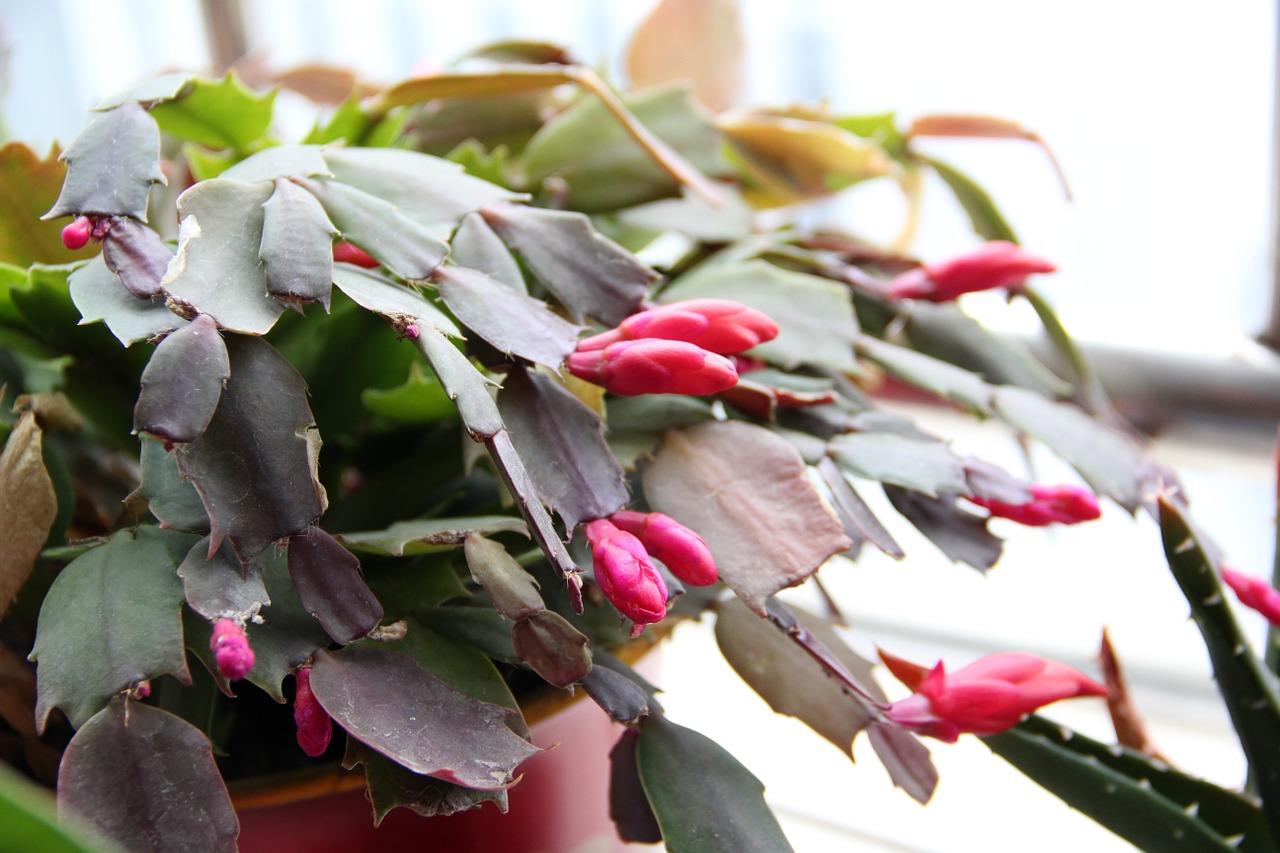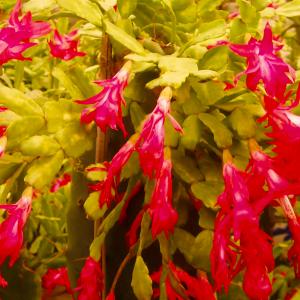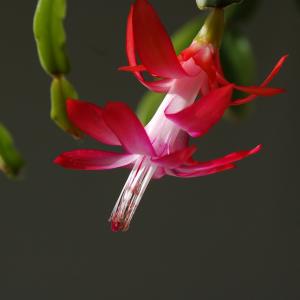文章
Dummer. ゛☀
2017年08月06日

BOTANICAL NAME: Schlumbergera hybrids
PLANT TYPE: Houseplant
SUN EXPOSURE: Part Sun
FLOWER COLOR: Pink
Christmas Cacti are easy to grow. When they bloom, they produce beautiful colors of pink or lilac. They have flatted leaves with rounded teeth on the margins.
Despite their name, Christmas cacti are not desert cacti. Their natural habit is one of an epiphyte living in tree branches in the rain forest of Brazil!
Also, note that there are several types of Holiday Cacti: Easter, Thanksgiving and Christmas. They bloom closest to the holiday of their name. That said, many florists do not know the difference. If you find your Christmas cactus blooming near Thanksgiving, guess what?
PLANTING
Christmas cacti grow in most container soils. Ensure the soil drains well and your pots have drainage holes.
Plants should be kept in bright, indirect light.
A daytime temperature of 70 degrees F and an evening temperature of 60 to 65 degrees F is preferred.
In the summer, Christmas cacti can be placed in a shady spot in the garden or in an unheated porch until temperatures get below 50 degrees.
CARE
From spring through early fall, feed every 2 weeks with a complete houseplant fertilizer. During the fall and winter feed the cactus monthly.
Allow soil to almost dry between waterings. If the stems look shriveled, it is an indication of too little watering. Watering is especially important during flowering.
Once flowers fade, continue to grow the plant as a houseplant.
Prune plants in June to encourage branching and more flowers. Simply cut off a few sections of each stem. Of you wish, root the cut-off pieces in moist vermiculite to make more plants.
If your cactus is not blooming, it may due to amount of daylight or temperature. Flowers will only form when the temperature is between a cool 50 to 55 degrees F.
Nights need to be at least 14 hours long and daylight periods are between 8 to 10 hours for 6 weeks—for six weeks. If you have strong indoor lighting, you may need to cover your cacti at night.
If the cacti sheds its buds in a winter, it will bloom the following year.
PESTS/DISEASES
If your Christmas Cacti is exposed to any type of stress, the plant will drop its blossoms. This could be related to amount of light, or a sudden change in temperature, as discussed in above plant care section. Also, ensure that your soil doesn’t get too dry.
The plant may be susceptible to mealy bugs and, if over-watered, root rot. If you have problems, cut out infected areas and repot in clean soil.
PLANT TYPE: Houseplant
SUN EXPOSURE: Part Sun
FLOWER COLOR: Pink
Christmas Cacti are easy to grow. When they bloom, they produce beautiful colors of pink or lilac. They have flatted leaves with rounded teeth on the margins.
Despite their name, Christmas cacti are not desert cacti. Their natural habit is one of an epiphyte living in tree branches in the rain forest of Brazil!
Also, note that there are several types of Holiday Cacti: Easter, Thanksgiving and Christmas. They bloom closest to the holiday of their name. That said, many florists do not know the difference. If you find your Christmas cactus blooming near Thanksgiving, guess what?
PLANTING
Christmas cacti grow in most container soils. Ensure the soil drains well and your pots have drainage holes.
Plants should be kept in bright, indirect light.
A daytime temperature of 70 degrees F and an evening temperature of 60 to 65 degrees F is preferred.
In the summer, Christmas cacti can be placed in a shady spot in the garden or in an unheated porch until temperatures get below 50 degrees.

CARE
From spring through early fall, feed every 2 weeks with a complete houseplant fertilizer. During the fall and winter feed the cactus monthly.
Allow soil to almost dry between waterings. If the stems look shriveled, it is an indication of too little watering. Watering is especially important during flowering.
Once flowers fade, continue to grow the plant as a houseplant.
Prune plants in June to encourage branching and more flowers. Simply cut off a few sections of each stem. Of you wish, root the cut-off pieces in moist vermiculite to make more plants.
If your cactus is not blooming, it may due to amount of daylight or temperature. Flowers will only form when the temperature is between a cool 50 to 55 degrees F.
Nights need to be at least 14 hours long and daylight periods are between 8 to 10 hours for 6 weeks—for six weeks. If you have strong indoor lighting, you may need to cover your cacti at night.
If the cacti sheds its buds in a winter, it will bloom the following year.

PESTS/DISEASES
If your Christmas Cacti is exposed to any type of stress, the plant will drop its blossoms. This could be related to amount of light, or a sudden change in temperature, as discussed in above plant care section. Also, ensure that your soil doesn’t get too dry.

The plant may be susceptible to mealy bugs and, if over-watered, root rot. If you have problems, cut out infected areas and repot in clean soil.
2
1
文章
玲儿
2017年07月09日

シャコバサボテンの基本情報
学名:Schlumbergera(Zygocactus)
和名:シャコバサボテン その他の名前:クリスマスカクタス、デンマークカクタス、カニバサボテン
科名 / 属名:サボテン科 / カニバサボテン属(シュルムベルゲラ属)
特徴
シュルムベルゲラ属の植物は、ブラジル南東部に6種が知られています。サボテンの仲間ですが、いずれも霧の多い森林の樹上に自生しています。日本で一般に出回っているのは、リオ・デ・ジャネイロ付近原産のシャコバサボテン(シュルムベルゲラ・トルンカタSchlumbergera truncata)と、カニバサボテン(S・ルッセリアナ S. russeliana)のほか、クリスマスカクタス(シュルムベルゲラ・バックリー S. × buckleyi)など、両種を中心とした交雑種です。
シャコバサボテン、およびシャコバサボテンの形質を色濃く残した交雑種は11月から12月に開花します。茎節(けいせつ:扁平になった茎。葉の機能をもつ)の突起がとがっているのが特徴です。カニバサボテン、およびカニバサボテンの形質を色濃く残した交雑種は1月から3月に開花する遅咲きです。茎節の突起が丸くなっています。シャコバサボテンとカニバサボテンの中間的な特徴を備えている交雑種もふえています。
シャコバサボテンの種類(原種、品種)
主な原種、園芸品種、仲間
‘ダーク・マリー’
Schlumbergera‘Dark Marie’
濃赤花の代表品種。分枝は少ないが大型で、大鉢仕立てに向く。中生。

‘ゴールド・チャーム’
Schlumbergera‘Gold Charm’
薄黄花の代表品種。分枝は少ないが大型で、大鉢仕立てに向く。晩生。

‘スーパー・ケーニガー’
Schlumbergera‘Super Koniger’
薄オレンジ花の品種。強健な大型品種。大鉢仕立てに向く。晩生。

‘エバ’
Schlumbergera‘Eva’
11月上旬から咲く、ピンク花の品種。分枝が多く、小葉で多花性。小鉢に向く。早生。

‘ピンク・ローズ’
Schlumbergera‘Pink Rose’
珍しいバラ咲きの立ち性品種。晩生。
‘パール・ウエーブ’
Schlumbergera‘Pearl Wave’
白い花弁にフリンジが入る、美しい立ち性品種。晩生。
‘チバ・ルビー’
Schlumbergera‘Chiba Ruby’
S・オプンチオイデス(S.opuntioides)とS・オルシチアナ(S.orssichiana)の交配種。棒のような茎節が特徴。国内での流通はほとんどなく、海外では観葉植物として扱われている。
コンペイトウ
Schlumbergera Konpeitou
葉が丸く巻き込み、蕾がピンク色で赤花のものをコンペイトウと呼ぶ。蕾のうちから赤いもの、白花やピンク花などもある。開花期も早生から晩生までさまざま。

学名:Schlumbergera(Zygocactus)
和名:シャコバサボテン その他の名前:クリスマスカクタス、デンマークカクタス、カニバサボテン
科名 / 属名:サボテン科 / カニバサボテン属(シュルムベルゲラ属)
特徴
シュルムベルゲラ属の植物は、ブラジル南東部に6種が知られています。サボテンの仲間ですが、いずれも霧の多い森林の樹上に自生しています。日本で一般に出回っているのは、リオ・デ・ジャネイロ付近原産のシャコバサボテン(シュルムベルゲラ・トルンカタSchlumbergera truncata)と、カニバサボテン(S・ルッセリアナ S. russeliana)のほか、クリスマスカクタス(シュルムベルゲラ・バックリー S. × buckleyi)など、両種を中心とした交雑種です。
シャコバサボテン、およびシャコバサボテンの形質を色濃く残した交雑種は11月から12月に開花します。茎節(けいせつ:扁平になった茎。葉の機能をもつ)の突起がとがっているのが特徴です。カニバサボテン、およびカニバサボテンの形質を色濃く残した交雑種は1月から3月に開花する遅咲きです。茎節の突起が丸くなっています。シャコバサボテンとカニバサボテンの中間的な特徴を備えている交雑種もふえています。
シャコバサボテンの種類(原種、品種)
主な原種、園芸品種、仲間
‘ダーク・マリー’
Schlumbergera‘Dark Marie’
濃赤花の代表品種。分枝は少ないが大型で、大鉢仕立てに向く。中生。

‘ゴールド・チャーム’
Schlumbergera‘Gold Charm’
薄黄花の代表品種。分枝は少ないが大型で、大鉢仕立てに向く。晩生。

‘スーパー・ケーニガー’
Schlumbergera‘Super Koniger’
薄オレンジ花の品種。強健な大型品種。大鉢仕立てに向く。晩生。

‘エバ’
Schlumbergera‘Eva’
11月上旬から咲く、ピンク花の品種。分枝が多く、小葉で多花性。小鉢に向く。早生。

‘ピンク・ローズ’
Schlumbergera‘Pink Rose’
珍しいバラ咲きの立ち性品種。晩生。
‘パール・ウエーブ’
Schlumbergera‘Pearl Wave’
白い花弁にフリンジが入る、美しい立ち性品種。晩生。
‘チバ・ルビー’
Schlumbergera‘Chiba Ruby’
S・オプンチオイデス(S.opuntioides)とS・オルシチアナ(S.orssichiana)の交配種。棒のような茎節が特徴。国内での流通はほとんどなく、海外では観葉植物として扱われている。
コンペイトウ
Schlumbergera Konpeitou
葉が丸く巻き込み、蕾がピンク色で赤花のものをコンペイトウと呼ぶ。蕾のうちから赤いもの、白花やピンク花などもある。開花期も早生から晩生までさまざま。

0
0
文章
linpei
2017年07月04日

A beautiful holiday plant (botanically known as Schlumbergera or Zygocactus), the Christmas Cactus unsurprisingly blooms at Christmas and also sometimes around Easter time if cared for properly. A month prior to Christmas you will be able to watch the tips of the leaves beginning to grow. The tips grow darker as each day passes, until a bud forms. At Christmas time, as if by magic, the buds open to a beautiful flower that will add color and warmth to any holiday season.
Choosing Your Spot, Soil, and Set-Up
1.Give your Christmas Cactus bright but indirect light. Keep the plant in a well-lit location (like near a window) away from direct sunlight – too much heat and light can stunt growth and burn the leaves. It should also be away from drafts, heat vents, fireplaces or other sources of hot air.[1]
Move an indoors plant outdoors in summer to a shady location. It is best to keep in a normal house temperature range, about 65 to 75°F (18 to 20°C). That being said, cooler night temperatures can be used to initiate blooming. We'll discuss getting it to bloom in the final section.
If it's in a north or east-facing window, you won't have to worry about light. But if it's in a south or west-facing window, diffuse the light with semi-transparent curtains or some other light-diffusing device.
2.Provide the plant a source of humidity if you live in a dry environment. Put a tray of water next to the plant so that the water evaporates and provides humidity. Alternatively, you can make a humidity tray by placing the pot on a waterproof saucer that is filled with gravel and halfway filled with water.
50 to 60% humidity is the ultimate goal.[2] If your environment is close to that, you should be fine.
3.Use a well-draining container and well-draining soil. For the container, some of the cheap nursery planters will work well, and orchid planters (the plastic basket kind) work well also. Pair this planter with a planter that will hold water and allow the basket to fit down into it. Then, place a few medium sized rocks into the bottom so that the basket container will be held about an inch above the bottom. [3]
Use a combination of 3 parts potting soil to one part sand for the potting medium. An alternative is one part potting soil, two parts peat moss or compost, and one part sharp sand or perlite.[4] Whichever way you go, pour about two inches of room temperature water into the outer container and set the basket container inside. After about twelve hours, pour out any remaining water. Repeat this as often as the plant needs water; it will vary based on your home's condition. Monitor its need with a moisture prod and adjust accordingly.
4.Add fertilizer to assist plant growth. Plants that are actively growing should be given a blooming houseplant-type fertilizer. This is best done for a plant that is 2-3 weeks old. Follow the label directions for how much and how often to feed.
Fertilizing is important to keep the plant in good condition; the joints are fragile and can break apart if the plant descends into poor health. Generally, it should be fertilized 2-4 times a year with a 20-20-20 feed, but stop feeding about a month before the buds appear (this usually means stopping by the end of October).

Watering Your Christmas Cactus
1.Water a Christmas Cactus with care. Caring for this plant can be a bit tricky as you need to take care not to overwater or underwater it:
A Christmas cactus is a tropical cactus, not a desert cactus. Unlike most desert cacti, this variety cannot tolerate completely dry soil. If the soil gets too dry, the flowers buds will drop, and the plant will wilt. Feel the soil with your fingers; if it feels dry, it's time to water.
Too much watering will cause spots from white rot to appear on the leaves, and the leaves will likely fall off. The soil should be evenly moist for best growth. The rule of thumb is less water is better than too much water.
When watering, thoroughly water the plant. Before attempting to water the plant again, check to see that the top inch of soil has dried thoroughly first. Mist leaves as well as watering the soil.
2.Change your watering schedule seasonally. Water the cactus based on your environment and the time of year. A good method is to water a cactus as follows:[5]
Dry climate, outdoors: Water every two to three days when warm and sunny
Humid, cool or indoors: Water every week
During the fall and winter months, the plants should be watered less frequently in order to promote blooming.
3.Stop watering around October. When October hits, your watering duties are over. You can carefully resume a light watering in November. If it's dry where you live, feel free to place the pot over a tray of moist pebbles. This is all to set up the bloom happening around Christmas.
The only other time you should cease watering is after the plant blooms. At this time, cease watering for about 6 weeks to allow the plant to rest. New growth will still appear – and that is when watering should be resumed.
4.Watch out for bud drop. One of the most frustrating things that can happen to Christmas cactus is after the flower buds have developed they drop off the plant. Bud drop can be caused by several different conditions. Usually it's because of over-watering, but it can also be due to a lack of humidity or insufficient light.
If this starts happening, water the plant less and add some fertilizer to the pot. Move it to an area away from a hot radiator or vent and try a new spot where it can get a bit more sunlight.

Getting a Timely Bloom
1.Encourage the flower blooming for the holiday season by lowering the temperature. The key to getting Christmas cactus to flower during the holiday season is proper light exposure, correct temperatures and limited watering. If you manipulate these things yourself, you can time a bloom just how you'd like.
Because this plant is thermo-photoperiodic, it will set buds when day length is about equal to night length and when the temperature drops to 50 to 60 degrees F for several weeks. If the temperature drops further, the plant will not bloom.
From September and October, the Christmas Cactus should be kept in a cool room where temperatures will remain around 50-55°F (10-12°C), give or take a few degrees. Don't expose the plant to freezing temperatures. Plants should be blooming for the holidays if cool treatments are started by early November.
2.Keep the plant in a dark room during the night. During the fall months, the Christmas Cactus should be placed in a spot where it receives indirect, bright light during the daylight hours but total darkness at night – it requires long, uninterrupted dark periods of about 12 hours or more.[6]
Begin the dark treatments in about mid-October to have plants in full bloom by the holidays. Place the plants in a dark area from about 12 or more hours each night for 6-8 weeks or until you see buds forming. A closet or unused bathroom are ideal places.
Be especially careful with watering at this time. Reduce the watering slightly. Do not soak the soil after a dry period; only moisten the top few inches, since buds, flowers and even leaves can fall off if the roots are suddenly saturated.
3.When you see flower buds forming, increase light and humidity. The "dark ages" are over when your plant starts budding. At this point, you should increase, humidity, light, water (not too much, of course), and the temperature. In other words, continue as you were a few months ago.
If the buds form too early, you can lower the temperature to stunt them. When you're ready, up the temperature and they should resume their progress.[7]

Caring for Your Cactus Post-Bloom
1.Prune the Christmas cactus about a month after blooming. This will encourage the plant to branch out, especially after a period of "rest" has been granted. It will not look very pretty after the blossoms have faded. Some people wait until March or so, when new growth begins, to prune the cactus.
As mentioned before, cease watering for 30 days post-bloom. When you see new growth forming, you can begin watering again.
2.Propagate a Christmas Cactus by cutting off short, Y-shaped sections of the stem. Each section must consist of two or three joined segments. Allow each section to dry for a few hours before pushing them into a 3-inch pot that contains the same potting soil as the parent plant. Plant halfway down the first segment and water sparingly to prevent rot from developing.[8]
Treat the cuttings as mature plants. In about four to six weeks, the cuttings should have rooted and will begin to show some new growth. They grow quickly, and should take in about two or three weeks. You can fertilize after the cutting has grown one new segment.
3.Repot every 2-3 years. Your plant should be fine for a couple of years unless the root system gets diseased or harmed. Apart from this, a new pot is needed when the roots have filled it or when the soil has been officially depleted of nutrients. Most people do this in the spring.
When replanting or repotting, use new, fresh soil. It's worth the few extra dollars since it will probably be sitting in that soil for a long time. Your plant is a living thing like you, so it deserves the best.
The best time for repotting is between February and April, about once every three years.[9] Just be sure not to give it a pot that's too big; the Christmas Cactus flowers best when it's pot-bound.

Choosing Your Spot, Soil, and Set-Up
1.Give your Christmas Cactus bright but indirect light. Keep the plant in a well-lit location (like near a window) away from direct sunlight – too much heat and light can stunt growth and burn the leaves. It should also be away from drafts, heat vents, fireplaces or other sources of hot air.[1]
Move an indoors plant outdoors in summer to a shady location. It is best to keep in a normal house temperature range, about 65 to 75°F (18 to 20°C). That being said, cooler night temperatures can be used to initiate blooming. We'll discuss getting it to bloom in the final section.
If it's in a north or east-facing window, you won't have to worry about light. But if it's in a south or west-facing window, diffuse the light with semi-transparent curtains or some other light-diffusing device.
2.Provide the plant a source of humidity if you live in a dry environment. Put a tray of water next to the plant so that the water evaporates and provides humidity. Alternatively, you can make a humidity tray by placing the pot on a waterproof saucer that is filled with gravel and halfway filled with water.
50 to 60% humidity is the ultimate goal.[2] If your environment is close to that, you should be fine.
3.Use a well-draining container and well-draining soil. For the container, some of the cheap nursery planters will work well, and orchid planters (the plastic basket kind) work well also. Pair this planter with a planter that will hold water and allow the basket to fit down into it. Then, place a few medium sized rocks into the bottom so that the basket container will be held about an inch above the bottom. [3]
Use a combination of 3 parts potting soil to one part sand for the potting medium. An alternative is one part potting soil, two parts peat moss or compost, and one part sharp sand or perlite.[4] Whichever way you go, pour about two inches of room temperature water into the outer container and set the basket container inside. After about twelve hours, pour out any remaining water. Repeat this as often as the plant needs water; it will vary based on your home's condition. Monitor its need with a moisture prod and adjust accordingly.
4.Add fertilizer to assist plant growth. Plants that are actively growing should be given a blooming houseplant-type fertilizer. This is best done for a plant that is 2-3 weeks old. Follow the label directions for how much and how often to feed.
Fertilizing is important to keep the plant in good condition; the joints are fragile and can break apart if the plant descends into poor health. Generally, it should be fertilized 2-4 times a year with a 20-20-20 feed, but stop feeding about a month before the buds appear (this usually means stopping by the end of October).

Watering Your Christmas Cactus
1.Water a Christmas Cactus with care. Caring for this plant can be a bit tricky as you need to take care not to overwater or underwater it:
A Christmas cactus is a tropical cactus, not a desert cactus. Unlike most desert cacti, this variety cannot tolerate completely dry soil. If the soil gets too dry, the flowers buds will drop, and the plant will wilt. Feel the soil with your fingers; if it feels dry, it's time to water.
Too much watering will cause spots from white rot to appear on the leaves, and the leaves will likely fall off. The soil should be evenly moist for best growth. The rule of thumb is less water is better than too much water.
When watering, thoroughly water the plant. Before attempting to water the plant again, check to see that the top inch of soil has dried thoroughly first. Mist leaves as well as watering the soil.
2.Change your watering schedule seasonally. Water the cactus based on your environment and the time of year. A good method is to water a cactus as follows:[5]
Dry climate, outdoors: Water every two to three days when warm and sunny
Humid, cool or indoors: Water every week
During the fall and winter months, the plants should be watered less frequently in order to promote blooming.
3.Stop watering around October. When October hits, your watering duties are over. You can carefully resume a light watering in November. If it's dry where you live, feel free to place the pot over a tray of moist pebbles. This is all to set up the bloom happening around Christmas.
The only other time you should cease watering is after the plant blooms. At this time, cease watering for about 6 weeks to allow the plant to rest. New growth will still appear – and that is when watering should be resumed.
4.Watch out for bud drop. One of the most frustrating things that can happen to Christmas cactus is after the flower buds have developed they drop off the plant. Bud drop can be caused by several different conditions. Usually it's because of over-watering, but it can also be due to a lack of humidity or insufficient light.
If this starts happening, water the plant less and add some fertilizer to the pot. Move it to an area away from a hot radiator or vent and try a new spot where it can get a bit more sunlight.

Getting a Timely Bloom
1.Encourage the flower blooming for the holiday season by lowering the temperature. The key to getting Christmas cactus to flower during the holiday season is proper light exposure, correct temperatures and limited watering. If you manipulate these things yourself, you can time a bloom just how you'd like.
Because this plant is thermo-photoperiodic, it will set buds when day length is about equal to night length and when the temperature drops to 50 to 60 degrees F for several weeks. If the temperature drops further, the plant will not bloom.
From September and October, the Christmas Cactus should be kept in a cool room where temperatures will remain around 50-55°F (10-12°C), give or take a few degrees. Don't expose the plant to freezing temperatures. Plants should be blooming for the holidays if cool treatments are started by early November.
2.Keep the plant in a dark room during the night. During the fall months, the Christmas Cactus should be placed in a spot where it receives indirect, bright light during the daylight hours but total darkness at night – it requires long, uninterrupted dark periods of about 12 hours or more.[6]
Begin the dark treatments in about mid-October to have plants in full bloom by the holidays. Place the plants in a dark area from about 12 or more hours each night for 6-8 weeks or until you see buds forming. A closet or unused bathroom are ideal places.
Be especially careful with watering at this time. Reduce the watering slightly. Do not soak the soil after a dry period; only moisten the top few inches, since buds, flowers and even leaves can fall off if the roots are suddenly saturated.
3.When you see flower buds forming, increase light and humidity. The "dark ages" are over when your plant starts budding. At this point, you should increase, humidity, light, water (not too much, of course), and the temperature. In other words, continue as you were a few months ago.
If the buds form too early, you can lower the temperature to stunt them. When you're ready, up the temperature and they should resume their progress.[7]

Caring for Your Cactus Post-Bloom
1.Prune the Christmas cactus about a month after blooming. This will encourage the plant to branch out, especially after a period of "rest" has been granted. It will not look very pretty after the blossoms have faded. Some people wait until March or so, when new growth begins, to prune the cactus.
As mentioned before, cease watering for 30 days post-bloom. When you see new growth forming, you can begin watering again.
2.Propagate a Christmas Cactus by cutting off short, Y-shaped sections of the stem. Each section must consist of two or three joined segments. Allow each section to dry for a few hours before pushing them into a 3-inch pot that contains the same potting soil as the parent plant. Plant halfway down the first segment and water sparingly to prevent rot from developing.[8]
Treat the cuttings as mature plants. In about four to six weeks, the cuttings should have rooted and will begin to show some new growth. They grow quickly, and should take in about two or three weeks. You can fertilize after the cutting has grown one new segment.
3.Repot every 2-3 years. Your plant should be fine for a couple of years unless the root system gets diseased or harmed. Apart from this, a new pot is needed when the roots have filled it or when the soil has been officially depleted of nutrients. Most people do this in the spring.
When replanting or repotting, use new, fresh soil. It's worth the few extra dollars since it will probably be sitting in that soil for a long time. Your plant is a living thing like you, so it deserves the best.
The best time for repotting is between February and April, about once every three years.[9] Just be sure not to give it a pot that's too big; the Christmas Cactus flowers best when it's pot-bound.

10
7
Miss Chen:溜溜溜
成长记
Josh Weesner
2017年06月25日

I new added a "Schlumbergera x buckleyi - Christmas Cactus" in my "garden"


0
0










